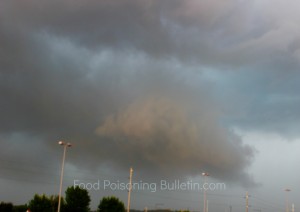The USDA’s Food Safety and Inspection Service (FSIS) is issuing food safety recommendations for the Northeast, Central Appalachians and Ohio Valley because of severe thunderstorms. These storms may cause power outages that could compromise the safety of food in consumers’ homes.
 If the power goes out, keep appliance thermometers in the refrigerator and freezer. Safe temperatures are 40°F or lower in the refrigerator and 0°F or lower in the freezer. Freeze water in 1-quart containers before the storm to help keep food cold. They can be put around the food in both appliances to keep food cold.
If the power goes out, keep appliance thermometers in the refrigerator and freezer. Safe temperatures are 40°F or lower in the refrigerator and 0°F or lower in the freezer. Freeze water in 1-quart containers before the storm to help keep food cold. They can be put around the food in both appliances to keep food cold.
Freeze leftovers, milk, and fresh meat and poultry before the storm to keep them at a safe temperature longer. Know where you can get block or dry ice to help keep food cold. Fifty pounds of dry ice can keep a fully stocked 18-cubic feet freezer cold for two days. And have coolers on hand to keep food cold if the power is out for more than 4 hours.
Group foods together in the freezer. This creates an “igloo” effect that keeps food cold longer. Keep the refrigerator and freezer doors closed as much as possible. A fridge can keep food cold for 4 hours if the door is closed; a full freezer will hold a safe temperature for 48 hours if full; 24 hours if half-full.
Place meat and poultry to one side of the freezer or on a tray to minimize cross-contamination from juices if the products thaw. And keep some ready-to-eat, shelf-stable foods such as canned beans and tuna on hand in case you can’t use your kitchen appliances.
After the storm, check the temperature inside the fridge and freezer. Discard any perishable foods that have been above 40°F for more than two hours. Check every item individually and throw out food that is warm to the touch or has a strange color, texture, or odor. Remember that food contaminated with bacteria will not look, smell, or taste strange or off.
Never test a food to decide if it is safe, and when in doubt, throw it out. You can see videos about food safety at YouTube.




